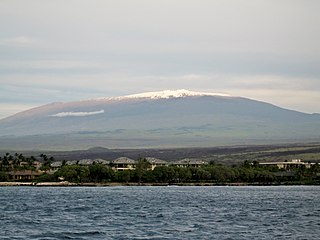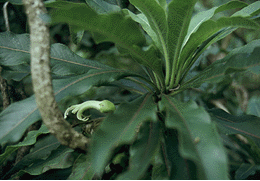
Mauna Kea is a dormant shield volcano on the island of Hawaiʻi. Its peak is 4,207.3 m (13,803 ft) above sea level, making it the highest point in Hawaii and the island with the second highest high point, behind New Guinea, the world's largest tropical island with multiple peaks that are higher. The peak is about 38 m (125 ft) higher than Mauna Loa, its more massive neighbor. Mauna Kea is unusually topographically prominent for its height: its prominence from sea level is fifteenth in the world among mountains, at 4,207.3 m (13,803 ft); its prominence from under the ocean is 9,330 m (30,610 ft), rivaled only by Mount Everest. This dry prominence is greater than Everest's height above sea level of 8,848.86 m (29,032 ft), and some authorities have labeled Mauna Kea the tallest mountain in the world, from its underwater base. Mauna Kea is ranked 8th by topographic isolation.

Argyroxiphium is a small genus of plants in the family Asteraceae. Its members are known by the common names silversword or greensword due to their long, narrow leaves and the silvery hairs on some species. The silverswords belong to a larger radiation of over 50 species, including the physically different genera Dubautia and Wilkesia. This grouping is often referred to as the silversword alliance. Botanist P. H. Raven referred to this radiation as "the best example of adaptive radiation in plants".

The Mauna Loa silversword, Argyroxiphium kauense, or Kaʻū silversword, is a rare species of flowering plant in the aster family. It is endemic to the eastern and southern slopes of Mauna Loa on the island of Hawaiʻi. A. kauense occurs in mountainous shrublands, bogs, and open mesic forest. The species is managed by the National Park Service and Hawaiʻi State Department of Forestry and Wildlife. It is a federally listed endangered species of the United States. There are three known populations remaining, for a total of fewer than 1000 individuals.

Dubautia arborea, the tree dubautia or Mauna Kea dubautia, is a species of flowering plant in the family Asteraceae. A member of the silversword alliance, it is endemic to the island of Hawaiʻi. It is a shrub or small tree. It is an endangered species that is threatened by feral grazing animals.

Argyroxiphium sandwicense subsp. sandwicense, the Mauna Kea silversword, is a highly endangered flowering plant endemic to the island of Hawaiʻi of Hawaii. It is the "crown jewel" of the volcanic mountain Mauna Kea, from which it derives its English name. The Hawaiian name is ʻahinahina; it applies to silverswords more broadly. The Mauna Kea silversword was once common on the volcano, and extraordinary conservation efforts are being made to preserve the species.

Clermontia pyrularia is a rare species of flowering plant in the bellflower family known by the common names Hamakua clermontia and pear clermontia. It is one of several Hawaiian lobelioids in genus Clermontia that are known as ʻoha wai and haha. It is endemic to the island of Hawaiʻi, where there is one remaining wild population containing 15 individuals and several propagated individuals that have been planted in protected habitat. This is a federally listed endangered species of the United States.
Cyanea glabra is a rare species of flowering plant in the family Campanulaceae known by the common name smooth cyanea. It is endemic to Maui, where there are twelve plants remaining in the wild. It was federally listed as an endangered species of the United States with nine other Maui Nui endemics in 1999. Like other Cyanea it is known as haha in Hawaiian.
Cyanea procera is a rare species of flowering plant in the bellflower family known by the common name Molokai cyanea. It is endemic to Hawaii, where it is known only from the island of Molokaʻi. It is a federally listed endangered species of the United States. Like other Cyanea it is known as haha in Hawaiian.

Cyrtandra is a genus of flowering plants containing about 600 species, with more being discovered often, and is thus the largest genus in the family Gesneriaceae. These plants are native to Southeast Asia, Australia, and the Pacific Islands, with the centre of diversity in Southeast Asia and the Malesian region. The genus is common, but many species within it are very rare, localized, and endangered endemic plants. The species can be difficult to identify because they are highly polymorphic and because they readily hybridize with each other. The plants may be small herbs, vines, shrubs, epiphytes, or trees. The genus is characterized in part by having two stamens, and most species have white flowers, with a few red-, orange-, yellow-, and pink-flowered species known. Almost all species live in rainforest habitats.
Cyrtandra crenata is a rare species of flowering plant belonging to the African violet family known by the common name Kahana Valley cyrtandra. It is endemic to Oahu in Hawaii, where it is known to be found only from the Koolau Mountains. It has not been seen since 1947, however, and it is feared to be extinct. The habitat is steep and inaccessible in some areas, so it is possible that specimens of this species still exist in the wild. It was federally listed an endangered species of the United States in 1994. This shrub grows 1 to 2 meters tall and bears white flowers. Like other Hawaiian Cyrtandra it is called ha`iwale.
Cyrtandra dentata is a rare species of flowering plant in the African violet family known by the common names mountain cyrtandra and sharp-toothed cyrtandra. It is endemic to Oahu in Hawaii, where the most recent count estimates 1640 plants occurring in the Waianae Mountains and Koʻolau Mountains. It is a shrub which can reach 5 meters tall and bears white flowers. It was federally listed as an endangered species in 1996. Like other Hawaiian Cyrtandra it is called ha`iwale.
Cyrtandra paliku is a rare species of flowering plant in the African violet family known by the common name cliffside cyrtandra. It is endemic to Hawaii, where it is known only from the island of Kauai. The plant was first discovered in 1993 and it was described to science as a new species in 2001. At the time it was discovered there was only one population containing 70 individuals; a 2006 count revealed only ten plants remaining. It was federally listed as an endangered species in 2010. Like other Hawaiian Cyrtandra it is called ha`iwale.
Cyrtandra polyantha is a rare species of flowering plant in the African violet family known by the common names Niu Valley cyrtandra. It is endemic to the Hawaii, where it is known only from the Koʻolau Mountains of Oahu. In 2007 there were only two populations containing a total of 46 mature plants, but one of the two populations is made up of a single individual. It was federally listed as an endangered species in 1994. Like other Hawaiian Cyrtandra it is called ha`iwale.
Cyrtandra subumbellata is a rare species of flowering plant in the African violet family known by the common name parasol cyrtandra. It is endemic to Hawaii, where it is known only from the Koʻolau Mountains on the island of Oahu. By 2008 there were three known populations containing 110 plants, or possibly more. It was federally listed as an endangered species in 1996. Like other Hawaiian Cyrtandra it is called ha`iwale.
Cyrtandra tintinnabula is a rare species of flowering plant in the African violet family known by the common name Laupahoehoe cyrtandra. It is endemic to the island of Hawaii, where it is known only from the slopes of Mauna Kea. As of 1996 there were only three occurrences containing fewer than 20 individuals total. It was federally listed as an endangered species in 1994. Like other Hawaiian Cyrtandra it is called ha`iwale.
Cyrtandra viridiflora is a rare species of flowering plant in the African violet family. It is endemic to Hawaii, where it is known only from the northern Koolau Mountains of Oahu. By 2003 there were nine small populations remaining, for a total of 69 plants. It was federally listed as an endangered species in 1996. Like other Hawaiian Cyrtandra it is called ha`iwale.
Cyrtandra waiolani is a species of plant in the family Gesneriaceae. The species was endemic to Koʻolau Range in Hawaii, and is extinct in the wild.

Cyrtandra heinrichii, known as ha'iwale or lava cyrtandra, is a perennial flowering plant in the family Gesneriaceae. It is found on the Hawaiian island of Kauai.

Cyrtandra wawrae, the rockface cyrtandra, is a species of flowering plant in the family Gesneriaceae, native to Kauai, Hawaii. A shrub reaching 10 ft (3 m), it is often found growing on rock walls.









